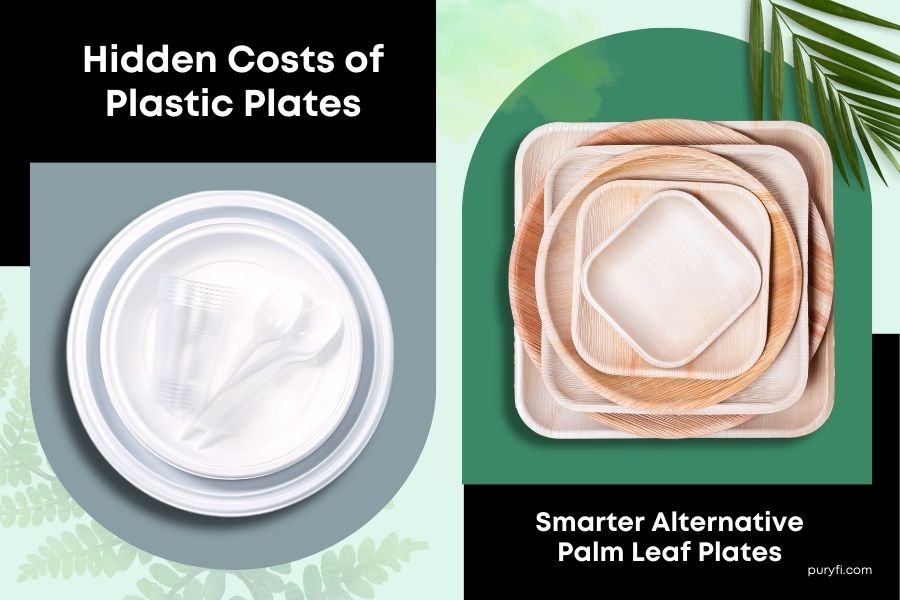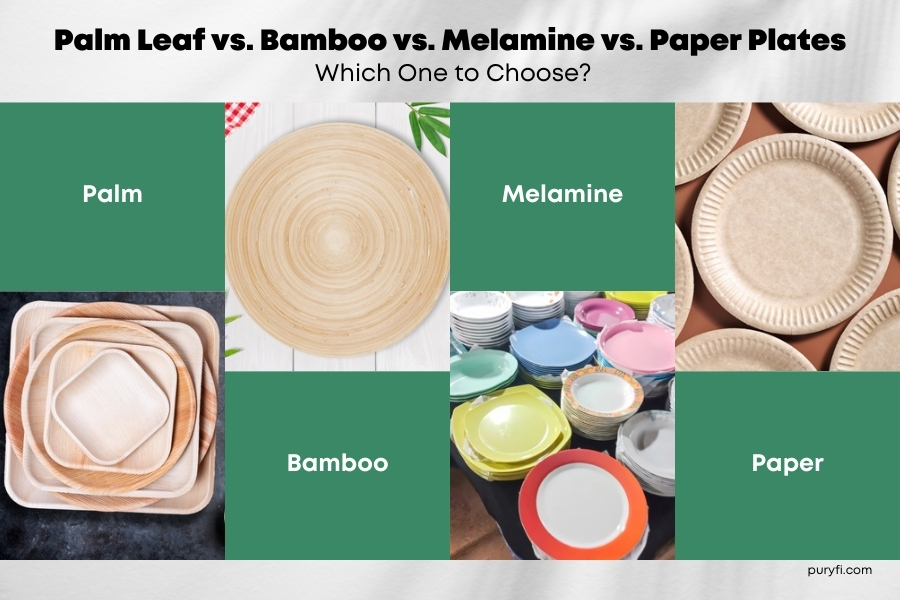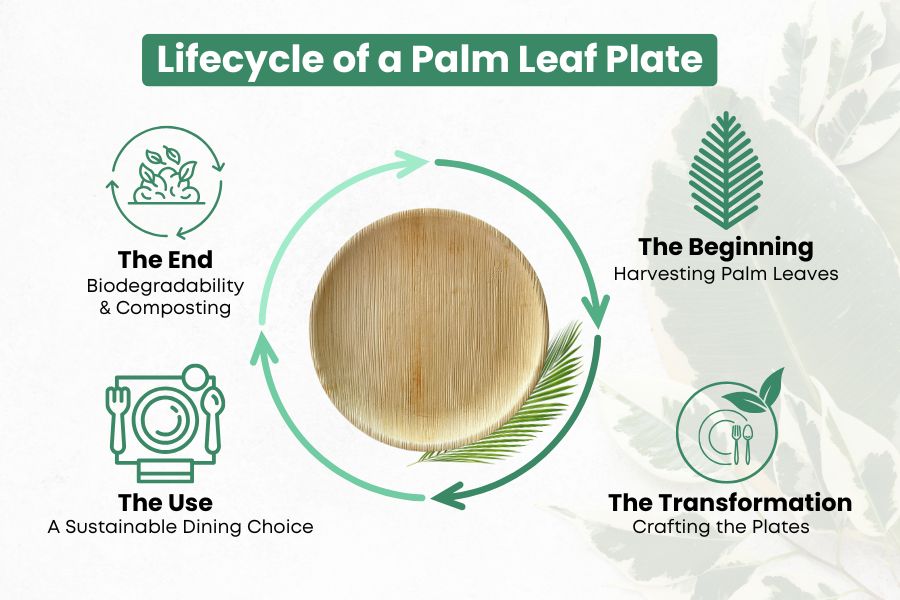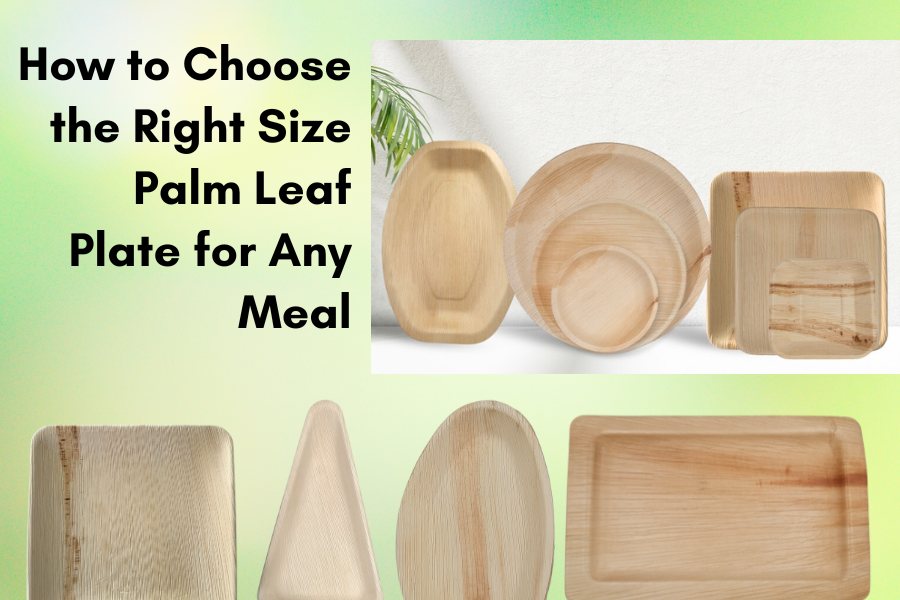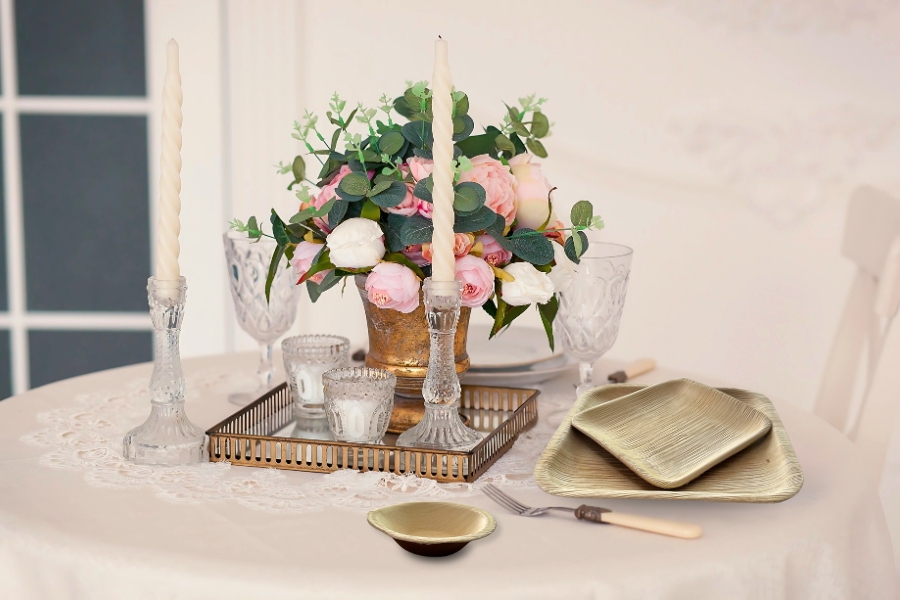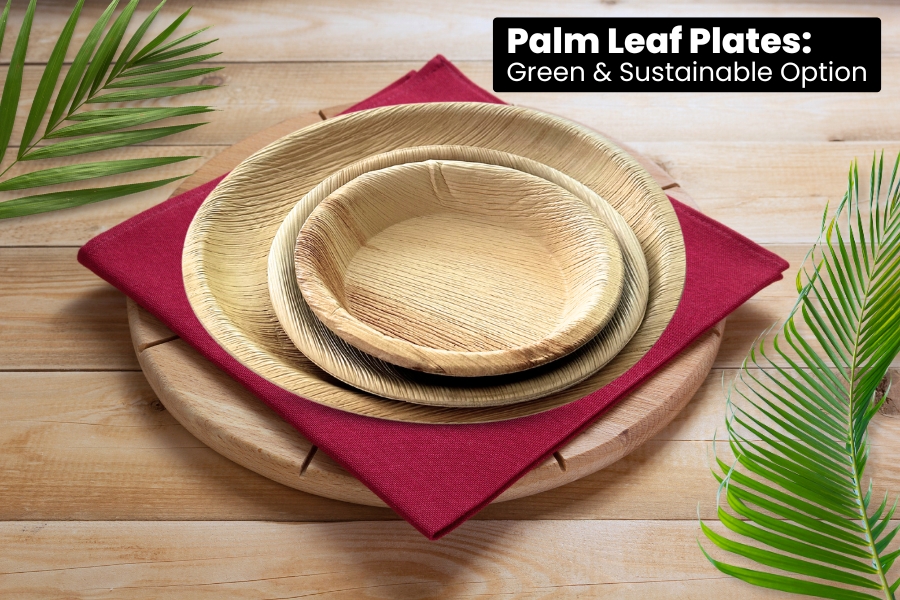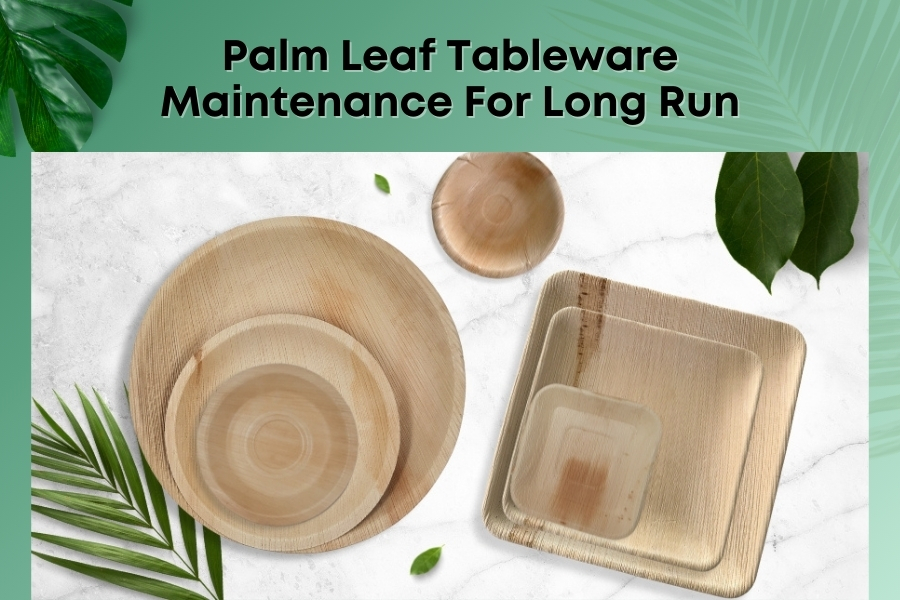Have you ever grabbed a stack of plastic plates for a party, thinking they were the easiest and cheapest option? It’s a no-brainer. But what if those “cheap” plates were costing you—and the environment—more than you realized? From hidden health risks to long-term environmental damage, plastic tableware is priced beyond the checkout counter. Keep reading to uncover the real cost of using plastic tableware and why palm leaf plates are the smarter choice. The True Cost of Plastic Plates At first glance, the cost of plastic plates is minimal. However, the disadvantages of plastic plates extend far beyond their purchase price. Here’s why they are not as economical as they seem: 1. Environmental Damage and Cleanup Costs One of the biggest hidden costs of plastic is its contribution to environmental pollution. Single-use plastic plates are neither biodegradable nor compostable, which means they end up in landfills or, worse, in oceans and waterways. Governments and taxpayers bear the financial burden of waste management, beach cleanups, and pollution mitigation. 2. Are Plastic Plates Recyclable? While some plastic plates are technically recyclable, the reality is that most of them are not. Many plastic products are made from polystyrene (Styrofoam) or other non-recyclable plastics. Even when they are recyclable, food residue often makes them unsuitable for processing. Contaminated plates can clog machinery, lower the quality of recycled material, and even cause entire batches to be discarded. Additionally, certain plastics, like polystyrene, are difficult and costly to recycle due to their lightweight structure and low market value. As a result, most plastic end up in landfills or incinerators rather than being repurposed. This means they contribute to the growing problem of plastic waste, requiring expensive disposal solutions. 3. Health Risks and Medical Costs Are plastic plates bad for you? The answer is complicated. Many plastic plates contain harmful chemicals like BPA and phthalates, which can leach into food, especially when exposed to heat. The long-term health costs associated with plastic use are rarely considered when making purchasing decisions, but they can be substantial. 4. Are Plastic Plates Microwave Safe? Can you put plastic plates in the microwave? The short answer: it depends. Some plastic containers claim to be microwave-safe, but repeated heating can break down plastic, increasing the likelihood of chemical leaching. If you’ve ever wondered, “Are plastic plates safe?” the reality is that many of them pose potential risks, particularly when heated. This makes them a poor choice for reheating food, leading consumers to spend more on safer alternatives. 5. Short Lifespan and Repeat Purchases Unlike durable alternatives, plastic tableware is designed for single-use or limited reuse. This means consumers must repeatedly purchase them, adding up over time. In contrast, biodegradable options like palm leaf plates are sturdier and don’t require constant repurchasing, making them a more cost-effective choice. How Palm Leaf Plates Save You Money Switching from plastic to palm leaf plates offers numerous benefits, both financially and environmentally. Here’s why they are the smarter investment: 1. Biodegradability Reduces Waste Management Costs Unlike plastic plates that sit in landfills for centuries, palm leaf plates are completely biodegradable and compostable. This reduces the burden on waste management systems and eliminates the hidden cost of long-term environmental damage. 2. No Need for Recycling Infrastructure Palm leaf plates don’t require specialized recycling facilities. They break down naturally, even in your backyard compost, making disposal easy and eco-friendly. This helps municipalities and businesses save money on waste processing costs while allowing consumers to dispose of them effortlessly without worrying about proper recycling methods. To know more about backyard composting, read our blog: How to Make Compost at Home: A Step-by-Step Guide to Sustainable Living 3. Health-safe and Chemical-Free (Even When Heated!) Palm leaf plates contain no artificial chemicals, ensuring they are safe for both hot and cold foods. Unlike plastic plates, they do not leach harmful substances when heated. Are palm leaf plates microwave-safe? Yes! Unlike plastic, palm leaf plates can safely withstand heat without releasing toxins, making them a much safer option for food reheating. 4. Durability Reduces Replacement Costs Palm leaf plates are far more durable than plastic alternatives. They hold up well to hot and heavy foods without bending or leaking, reducing the need for double stacking or using multiple plates per meal. This means fewer plates are needed per event, leading to cost savings over time. 5. Sustainable Sourcing Saves Natural Resources Palm leaf plates are made from naturally shed leaves, making them an eco-friendly and sustainable choice. Unlike plastic production, which relies on fossil fuels and contributes to greenhouse gas emissions, palm leaf plates have a minimal environmental footprint. This sustainability reduces long-term environmental costs that often translate into higher taxes and expenses for consumers. The Bigger Picture: Long-Term Savings and Sustainability When comparing the cost of plastic plates to palm leaf alternatives, it’s essential to look beyond the price tag. Plastic has financial and environmental consequences that make it a far more expensive choice in the long run. Palm leaf tableware, while slightly higher in upfront cost, offers durability, safety, and sustainability—leading to significant savings over time. Governments, businesses, and consumers alike are shifting toward sustainable alternatives. Many regions are even banning single-use plastics, making the switch to biodegradable options inevitable. Choosing palm leaf plates now can help you stay ahead of regulations while contributing to a healthier planet. Final Thoughts The disadvantages of plastic plates go far beyond their initial price. One of the biggest concerns remains: Are plastic plates microwave-safe? While some are labeled safe, the risks of chemical leaching make them a questionable option for regular use. On the other hand, palm leaf plates provide a sustainable, durable, and cost-effective alternative. They are microwave-safe, free from harmful chemicals, and better for the environment. By making the switch, you save money and contribute to a cleaner, healthier world. Next time you reach for plastic, consider the bigger picture. Investing in palm leaf plates is a smart financial and environmental decision that benefits everyone in the long run.
Palm Leaf vs. Bamboo vs. Melamine vs. Paper Plates: Which One to Choose?
We all care about making eco-friendly choices, and selecting sustainable tableware is a great start. But are you picking the option that truly minimizes your environmental impact? Well, when it comes to choosing the right type of plates for your meals, parties, or events, the options can be overwhelming. Each material has advantages and drawbacks, from eco-friendly alternatives like palm leaf plates, bamboo plates, and paper plates to durable and reusable melamine plates. The best choice depends on various factors like sustainability, durability, cost, and convenience. In this article, we will compare four popular options—palm leaf, bamboo, paper, and melamine—so you can choose the one that best fits your needs and lifestyle. Palm Leaf Plates Palm leaf disposable plates are made from naturally shed leaves of the Areca palm tree, making them one of the most sustainable options. They are biodegradable, compostable, and free from chemicals or toxins. Pros: Cons: To know more about palm leaf plates and other tableware, read our blog: The Journey of Palm Leaf Tableware: From Forest to Your Table Bamboo Plates Bamboo plates are another eco-friendly alternative, obtained from bamboo fibers or solid bamboo. They can be reusable or compostable, depending on the type. Pros: Cons: Melamine Plates Melamine plates are a durable, reusable option often found in homes and restaurants. Made from a type of plastic resin, melamine plates are shatter-resistant and come in various designs. Pros: Cons: Paper Plates Paper plates are a popular choice for convenience and affordability. They are widely available and commonly used for picnics, parties, and casual meals. Pros: Cons: Comparison Table Which One Should You Choose? The best option depends on your needs. Here are some key takeaways to help you decide: Frequently Asked Questions Both are eco-friendly choices, but palm leaf plates are sturdier, microwave-safe, and fully compostable. Bamboo plates are reusable but may require special care. The best option depends on whether you need disposable or long-term use. 2. Are bamboo plates non-toxic? Are bamboo plates safe? Bamboo plates are non-toxic and safe for food if made from 100% natural bamboo without added chemicals or resins. Yes, bamboo plates are generally safe when made from natural bamboo without harmful additives. 3. Are paper plates safe? Most paper plates are safe for dry foods, but some may have plastic or chemical coatings that are not heat resistant. Opt for uncoated, compostable paper plates for the safest option. 4. Are bamboo plates toxic? Bamboo plates with melamine or synthetic binders may contain harmful substances. Always choose BPA-free, food-grade bamboo tableware to avoid toxicity concerns. 5. Are melamine plates safe? Melamine plates are durable and lightweight, but they should not be used in the microwave or exposed to high temperatures, as melamine can leach into food when heated. Final Words Each type of plate has its pros and cons, but palm leaf plates stand out as the best choice. They are eco-friendly, biodegradable, and sturdy enough for various uses. While paper plates are cheap and convenient, they generate waste, and melamine plates, though durable, are not biodegradable. Bamboo plates are also sustainable, but palm leaf plates offer the best balance of strength, aesthetics, and environmental benefits. Weighing these factors, palm leaf plates emerge as the top option for those who prioritize sustainability without compromising on quality.
The Lifecycle of a Palm Leaf Plate: From Nature Back to Nature
In an era where sustainability is more than just a trend, eco-friendly alternatives to everyday items are gaining popularity. One such innovation is the palm leaf plate—a biodegradable, compostable, and aesthetically pleasing alternative to plastic or paper dinnerware. But have you ever wondered about the journey of a palm leaf plate? Let’s explore its lifecycle, from nature to disposal and back to nature again. The Beginning: Harvesting Palm Leaves Palm leaf plates originate from the shredded leaves of the Areca palm tree, which grows abundantly in tropical regions. These trees naturally shed their leaves, eliminating the need to cut down trees or harm the environment. Instead of letting these leaves decompose or go to waste, they are collected and repurposed into durable, eco-friendly tableware. The Transformation: Crafting the Plates Once the shredded leaves are gathered, they undergo a thorough cleaning process to remove dirt and impurities. The cleaned leaves are then heat-pressed into various shapes and sizes using specialized molds. This process requires no chemicals, dyes, or synthetic additives, making palm leaf plates completely natural and food-safe. The result is a sturdy, lightweight, and elegant plate that can withstand hot and cold foods without leaking or becoming soggy. Additionally, skilled artisans ensure that each plate is crafted with precision, maintaining the natural textures and patterns of the leaf. This adds to the uniqueness of each plate, making them not only functional but also visually appealing. The minimal use of resources in this process further contributes to their sustainability. The Use: A Sustainable Dining Choice Palm leaf plates are versatile and can be used for various occasions, from casual picnics to upscale events. Their rustic and earthy appearance makes them a famous choice for eco-conscious consumers and event planners. Unlike plastic or Styrofoam alternatives, palm leaf plates are free from harmful toxins, ensuring that they are safe for both humans and the environment. Many restaurants, caterers, and hospitality businesses are now adopting palm leaf plates as part of their sustainability efforts. Their durability and ability to handle a variety of cuisines make them an excellent alternative to disposable plastic plates. Additionally, their lightweight nature makes them easy to transport and store, adding to their convenience. The End: Biodegradability and Composting The true beauty of palm leaf plates lies in their return to nature. After use, they can be composted at home or in industrial composting facilities. Within 6 to 8 weeks, they break down into nutrient-rich organic matter, enriching the soil without leaving behind harmful residues Unlike plastic, which can take hundreds of years to decompose, palm leaf plates complete their cycle in a fraction of the time, making them a truly sustainable choice. Moreover, even if they are discarded in an open environment, they decompose naturally without polluting the surroundings. This makes them an ideal choice for outdoor events, camping, and large gatherings where waste management might be challenging. To know more about the journey of palm leaf plates, read our blog: The Journey of Palm Leaf Tableware: From Forest to Your Table Additional Benefits of Palm Leaf Plates Beyond their environmental advantages, palm leaf plates offer several other benefits: Conclusion: A Full-Circle Sustainability Approach The lifecycle of a palm leaf plate is a testament to the power of sustainable innovation. From its humble beginnings as a dropped leaf to serving as a great dinnerware choice and finally decomposing back into the earth, it follows a complete eco-friendly cycle. By palm leaf plates, we contribute to a greener planet, reducing our dependence on plastic and minimizing waste. As we continue to seek sustainable alternatives, palm leaf plates stand as a reminder that nature provides us with everything we need without harming the surroundings. Next time you host a gathering or enjoy a meal, consider making the switch and be a part of the movement towards a cleaner, greener future. By making mindful choices today, we can ensure a healthier planet for coming generations.
Breaking Down Biodegradability: How Long Do Palm Leaf Plates Take to Decompose?
As sustainability gains momentum, eco-conscious consumers turn to biodegradable alternatives like palm leaf plates. These stylish, sturdy, and compostable plates offer a green solution to traditional plastic or paper disposables. But how long do palm leaf plates take to decompose? Let’s break it down. What Makes Palm Leaf Plates Biodegradable? Palm leaf plates are crafted from naturally shredded areca palm leaves. Unlike plastic or chemically treated disposable plates, they undergo minimal processing—typically just cleaning, heat-pressing, and shaping. Since they contain no synthetic additives or coatings, they break down naturally without harming the environment. How Long Do Palm Leaf Plates Take to Decompose? One of the most attractive features of palm leaf plates is their rapid decomposition. Under the right conditions, they can fully decompose within 60 to 90 days. However, the exact time frame depends on several factors: Composting Conditions: In a well-maintained composting system with adequate moisture, oxygen, and microbial activity, palm leaf plates break down faster. Soil & Climate: Warmer and more humid environments speed up decomposition, while dry or cold conditions may slow the process. Disposal Method: Plates left in a backyard compost pile degrade in a few months, whereas landfill conditions may prolong decomposition due to lack of oxygen. How Much Time Palm Leaf Plates Take to Dispose Compared to Other Materials? Best Ways to Dispose of Palm Leaf Plates To maximize the eco-friendly benefits of palm leaf plates, consider these sustainable disposal methods: 1. Composting (Best Option) Palm leaf plates break down quickly in compost bins and provide nutrient-rich organic matter for soil. Both home composting and industrial composting facilities work well. 2. Burying in Soil If you don’t have a compost bin, you can bury palm leaf plates in your garden. The natural microbes in the soil will break them down while enriching the earth. 3. Municipal Organic Waste Bins Some cities have organic waste collection programs that accept biodegradable tableware. Check local regulations to see if palm leaf plates are allowed in your green waste bin. 4. Avoiding Landfills While palm leaf plates will eventually break down in a landfill, they decompose much slower due to the lack of oxygen and microbial activity. Composting or soil burial is a far better alternative. The Bigger Picture: Why Choose Palm Leaf Plates? Choosing palm leaf plates isn’t just about convenience—it’s a step toward reducing waste and protecting the environment. Here’s why they stand out: ✅ Zero Chemicals – No artificial coatings, dyes, or glues. ✅ Sustainable Sourcing – Made from shredded leaves, not harvested trees. ✅ Biodegradable & Compostable – Breaks down in months, not centuries. ✅ Sturdy & Durable – Holds up well with hot, cold, and oily foods. ✅ Elegant & Natural Look – Perfect for eco-conscious events. By switching to palm leaf plates, you’re making a small but powerful change toward a more sustainable lifestyle. Every eco-friendly choice we make—no matter how small—contributes to a healthier planet for future generations. So, next time you’re planning a picnic, party, or catered event, consider ditching plastic and opting for palm leaf plates instead. Your guests will appreciate their natural beauty, and Mother Earth will thank you.
How to Choose the Right Size Palm Leaf Plate for Any Meal
Regarding sustainable dining options, palm leaf plates are a standout choice. Not only are they eco-friendly and biodegradable, but they also bring an elegant, natural touch to any meal setting. However, selecting the right size plate can sometimes be confusing, especially with many available options. Whether you’re hosting a casual brunch, an elaborate dinner, or a festive outdoor barbecue, here’s a guide to help you pick the perfect size palm leaf plate for every occasion. Understanding the Meal Type The type of meal you’re serving is the most critical factor in determining the right plate size. Consider the following scenarios: Event Style and Setting The setting of your event plays a key role in plate selection. For example: Shape Matters Too Palm leaf plates come in a variety of shapes, including round, square, oval, and even rectangular. While size is the primary consideration, the shape can enhance the presentation. For example: Different Sizes of Palm Leaf Plates Palm leaf plates are the perfect combination of sustainability and elegance, but choosing the right size for your meal or event can be tricky. From appetizers to desserts, each plate size has its own ideal use case. For instance, Conclusion Choosing the right size palm leaf plate doesn’t have to be daunting. By considering the type of meal, event style, portion size, and plate shape, you can ensure a seamless dining experience that’s as functional as it is environmentally friendly. With the perfect palm-leaf plates, your guests will enjoy the meal and appreciate your commitment to sustainability. Elevate your next meal with the perfect palm leaf plate for the occasion and impress your guests with your sustainable choice!
Breaking Down the Costs: Are Palm Leaf Plates Affordable?
Palm leaf plates have gained immense popularity recently as an eco-friendly alternative to traditional disposable tableware. They’re stylish, biodegradable, and touted as a sustainable choice for those looking to minimize their environmental impact. However, one common question remains: Are palm leaf plates affordable? Let’s take a closer look at the costs associated with these plates and whether they fit into a budget-friendly lifestyle. Comparing Costs: Palm Leaf Plates vs. Traditional Options 1. Plastic Disposable Plates 2. Paper Plates 3. Palm Leaf Plates Factors Influencing the Cost of Palm Leaf Plates 1. Quantity Purchased Bulk purchases significantly reduce the per-plate cost of palm leaf tableware. For example, buying a pack of 100 plates might cost $30, compared to $0.70 per plate in smaller quantities. 2. Quality and Design Higher-quality plates with intricate designs or custom shapes tend to cost more. This premium might be worth the aesthetic and functionality if you’re hosting a special event. 3. Shipping and Availability Since palm leaf plates are often imported, shipping costs can impact affordability. Buying from local retailers or suppliers can help mitigate these costs. The Rise of Eco-Friendly Tableware The global shift towards sustainable living has significantly influenced the disposable tableware market. Consumers are becoming increasingly aware of the environmental impact of single-use plastics and are actively seeking alternatives. Plastic Pollution Crisis: Over 300 million tons of plastic are produced globally each year, with a significant portion ending up in landfills and oceans. Single-use plastics like plates and cutlery are major contributors to this problem. Legislation on Plastics: Many governments have introduced bans or taxes on single-use plastics, further driving the demand for sustainable alternatives like palm leaf plates. Palm leaf plates are part of a broader movement towards eco-friendly products that prioritize environmental health without compromising functionality. What Makes Palm Leaf Plates Stand Out? Palm leaf plates aren’t just another disposable tableware option; they offer unique benefits that set them apart: Sustainability: Made from shredded Areca palm leaves, their production involves no deforestation or harmful chemicals. Aesthetic Appeal: With natural textures and colors, palm leaf plates add an organic, upscale touch to any event. Versatility: They’re durable enough for hot, cold, and oily foods, making them suitable for diverse cuisines. Biodegradability: These plates decompose within 6–8 weeks in a composting environment, leaving no harmful residue behind. Are Palm Leaf Plates Right for You? The affordability of palm leaf plates depends on your priorities. For those focused on sustainability and reducing environmental impact, the slightly higher cost is a small price to pay for eco-friendly living. Bulk purchases can make them more cost-effective, especially for events like weddings, parties, or catering. If your primary goal is to minimize upfront expenses, traditional options like plastic or paper seem more appealing. However, considering the hidden costs—both environmental and functional—palm leaf plates offer exceptional value for their price.
How to Style a Gorgeous Tablescape with Palm Leaf Plates
Creating a stunning tablescape is a wonderful way to set the tone for any gathering, whether it’s an intimate dinner party, a festive celebration, or a casual outdoor picnic. Palm leaf plates offer an eco-friendly and chic alternative to traditional tableware, and their natural texture and earthy aesthetic make them versatile for various themes. Let’s explore how to style a gorgeous tablescape using palm leaf plates to wow your guests and elevate your event. Choose a Theme to Set the Mood Before you dive into styling, decide on a theme. Palm leaf plates pair beautifully with various styles, from tropical and bohemian to rustic and elegant. Consider the occasion and season: Having a clear theme ensures a cohesive and visually appealing tablescape. Layer Your Table Linens The foundation of a great tablescape lies in the linens. Start with a tablecloth or runner that complements your theme. For example: Layer with placemats in materials like jute, rattan, or metallic finishes to frame your palm leaf plates beautifully. Showcase the Palm Leaf Tableware Palm leaf tableware is naturally beautiful with its unique texture and pattern, so let it shine. Here’s how: Use Napkins & Glassware Palm leaf plates bring a neutral tone, so use your tablescape to add pops of color and interesting textures: Incorporate Ambient Lighting Lighting can transform your tablescape, especially for evening events. Personalize the Experience Small, thoughtful touches can make your tablescape even more special. Consider these ideas: Keep It Sustainable Palm leaf plates are biodegradable and sustainable, aligning perfectly with eco-conscious values. Complement them with other sustainable choices: Conclusion A beautifully styled tablescape with palm leaf plates sets the stage for memorable meals and meaningful connections. By combining natural elements, thoughtful details, and a cohesive theme, you can create a table setting that’s not only visually stunning but also sustainable and eco-friendly. Whether you’re hosting a casual brunch or a formal dinner, the versatility of palm leaf plates makes them a perfect choice for any occasion. So, gather your favorite elements, unleash your creativity, and let your tablescape reflect your personal style!
How Palm Leaf Plates Make It Affordable to Go Green
In today’s world, sustainability is more than just a trend—it’s a necessity. As environmental awareness rises, many individuals and businesses seek eco-friendly solutions to reduce waste and live sustainably. One of the most practical and affordable ways to make an eco-conscious choice is by using palm leaf plates. These biodegradable and stylish plates provide an accessible pathway to going green without breaking the bank. Here’s how palm leaf plates are revolutionizing sustainable living. A Brief to Palm Leaf Plates Palm leaf plates are natural, disposable tableware made from the shredded leaves of the Areca palm tree. These plates are crafted without chemicals, dyes, or toxins, making them 100% biodegradable and compostable. Unlike single-use plastic or Styrofoam products, palm leaf plates decompose naturally, leaving no harmful residue behind. Their natural appearance also makes them a favorite choice for events and gatherings looking to add an eco-chic touch. Affordable Sustainability: A Cost-Effective Green Choice One of the biggest misconceptions about sustainable products is that they come with a hefty price tag. Palm leaf plates challenge this narrative by offering an affordable alternative to conventional disposable plates. Durable and Versatile: Perfect For Any Occasion Palm leaf plates are not just eco-friendly; they’re also incredibly durable and versatile. Palm leaf plates can handle hot, cold, wet, or oily foods without leaking, unlike flimsy paper plates or plastic alternatives. This makes them ideal for: With their strength and stylish appearance, these plates often replace the need for separate serving dishes, further saving costs. Zero-Waste Lifestyle Made Simple Transitioning to a zero-waste lifestyle can feel overwhelming, but small changes like using palm leaf plates make the process more manageable. Here’s how they contribute to a greener lifestyle: Biodegradable: Once discarded, palm leaf plates decompose within 60 days, enriching the soil rather than polluting it. Composting: They can be added to home composting systems, reducing overall household waste. Reusable Option: For less messy meals, these plates can be gently cleaned and reused, extending their life cycle. Conclusion: Small Choices, Big Impact Palm leaf plates are proof that eco-friendly living can be stylish, practical, and affordable. By choosing these biodegradable plates, you’re not only making a sustainable choice for your home or event but also supporting a healthier planet for generations to come. So, the next time you’re planning a gathering or simply looking for greener everyday options, consider palm leaf plates. A small change can lead to a big impact, starting with the choices we make today.
The Revolution of Palm Leaf Tableware: Sustainable Dining for a Better Future
The growing concern over environmental degradation has prompted a significant shift in consumer habits, especially in the usage of disposable products. Among the most innovative solutions is palm leaf tableware, an eco-friendly alternative that is transforming how we think about single-use dining. This revolution is not just about a product but a broader movement towards sustainability, style, and practicality. Let’s explore how palm leaf tableware has emerged as a game-changer in sustainable living. A Humble Beginning: From Nature to Table Palm leaf tableware originates from a simple yet innovative idea: repurposing the naturally shedded leaves of the areca palm tree. Traditionally, these leaves were discarded or burned, contributing to waste. However, today, artisans collect these leaves, clean them, and press them into various shapes like plates, bowls, and trays. The result is a durable, biodegradable product that requires no harmful chemicals or additional materials Features That Redefine Disposable Tableware Unlike breakable plastic or paper alternatives, palm leaf tableware combines durability with natural aesthetics, making it suitable for casual picnics and formal events alike. Here’s what sets it apart: These features make palm leaf tableware more than a substitute—it’s an upgrade to conventional disposables. Cultural and Economic Impact The palm leaf tableware industry has fostered a positive impact on local economies, particularly in regions where areca palm trees are abundant. Pioneering Innovation in Sustainability As the demand for sustainable alternatives grows, companies are innovating within the palm leaf tableware industry: These innovations are propelling the revolution forward, proving that sustainability doesn’t have to compromise on style or functionality. Challenges and Future Potential While the rise of palm leaf tableware is promising, it’s not without challenges. Production scalability, cost competition with cheaper plastic alternatives, and raising awareness in global markets remain hurdles to overcome. However, the future looks bright: Conclusion: A Revolution Worth Joining The palm leaf tableware revolution is more than a trend—it’s a testament to the possibilities of sustainable innovation. It represents a harmonious blend of nature, technology, and human ingenuity, offering a solution to the pressing problem of disposable waste. By choosing palm leaf tableware, you’re not just opting for an eco-friendly product—you’re supporting a global movement toward a greener, more responsible future. As this revolution gains momentum, we all can contribute by making mindful choices and spreading awareness of its benefits. So, the next time you plan an event or need disposable dining options, let palm leaf tableware be your go-to choice. Together, we can revolutionize the way we eat, celebrate, and care for the planet.
How to Maintain Palm Leaf Tableware for Long Run
Palm leaf tableware has become popular for eco-conscious consumers seeking sustainable alternatives to traditional disposable products. Made from shredded palm leaves, this biodegradable tableware is stylish and environmentally friendly. If you’ve switched to palm leaf plates and bowls, it’s essential to know how to properly maintain them to ensure they last as long as possible. Here are some practical tips to help you keep your palm-leaf tableware in great shape. Palm Leaf Tableware Maintenance Tips 1. Keep it Dry Palm leaf tableware is naturally resistant to moisture, but prolonged exposure to water can cause it to lose its strength. To preserve the integrity of your palm leaf plates, bowls, and trays, avoid soaking them in water. 2. Store Properly When not in use, store your palm leaf tableware in a cool, dry place away from direct sunlight and excessive humidity. Avoid placing them in areas with high moisture levels, such as near dishwashers or sinks, as this can cause the material to weaken. A dry cabinet or shelf is ideal for storage, ensuring that your tableware remains in perfect condition for future use. 3. Use Only for the Intended Purpose While palm leaf tableware is durable, it’s important to remember that it is designed for single use or light, casual use. If you’re hosting a party or picnic, palm leaf plates are ideal for serving dry foods, salads, or snacks. However, they may not be the best choice for very greasy or saucy dishes, as excessive moisture can cause them to lose their shape. 4. Avoid Extreme Heat While these eco-friendly plates are durable, they are best suited for serving food at moderate temperatures. Avoid placing them in ovens, microwaves, or direct sunlight for extended durations to maintain their strength and aesthetic appeal. Proper care not only extends their usability but also upholds their sustainable charm. 5. Avoid Heavy Scrubbing When cleaning palm leaf tableware, avoid using abrasive scrubbing pads that may scratch or damage the surface. Instead, opt for a soft sponge or cloth to gently remove any food residue. This will ensure that your tableware retains its smooth, natural finish over time. 6. Repurpose and Recycle One of the benefits of palm leaf tableware is that it’s biodegradable and compostable. Once it has reached the end of its life, you can dispose of it in an eco-friendly manner by adding it to your compost bin. If you want to repurpose your palm leaf items, they can also be used for craft projects or as natural mulch in your garden. Conclusion By following these simple maintenance tips, you can extend the life of your palm leaf tableware and continue enjoying its eco-friendly benefits. This sustainable option is good for the environment and offers a unique and stylish alternative to traditional disposable products. With proper care and attention, your palm leaf tableware can last through many meals, parties, and special occasions while helping lower waste and promote sustainability.

